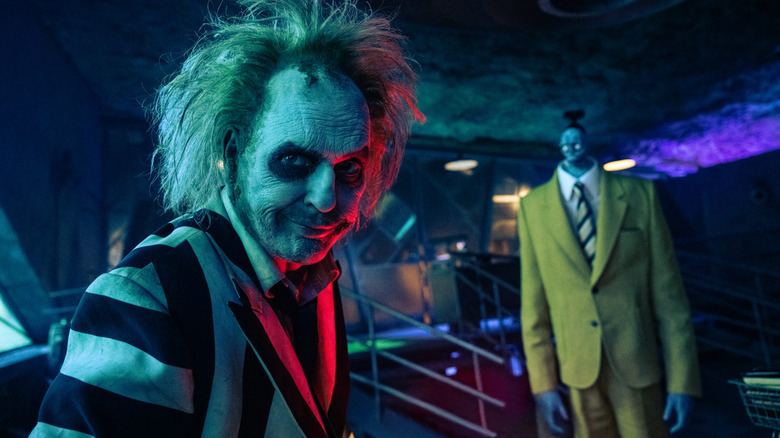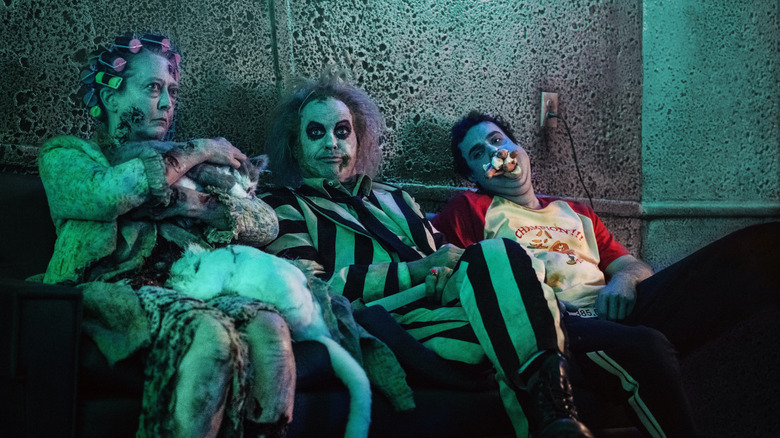Michael Keaton Had Two Conditions To Return For Beetlejuice Beetlejuice
To borrow a phrase from Ian Malcolm (Jeff Goldblum) in "Jurassic Park" — Now, eventually, you might have Beetlejuice in your "Beetlejuice" movie, right? It takes a while for Michael Keaton's "Ghost With the Most" to properly show up in Tim Burton's classic 1988 supernatural comedy, and even after that, he's only onscreen for a little over 17 minutes. In fact, Beetlejuice is mostly irrelevant to the plot, much of which centers around the lovable, recently-deceased Maitlands (Geena Davis and Alec Baldwin) trying and failing to scare the off-putting, still-breathing Deetzes (Catherine O'Hara, Jeffrey Jones, and Winona Ryder) from their home. It's only in the third act that Beetlejuice fully evolves into the film's antagonist, giving the two families a common enemy to unite against.
Nearly 40 years later, you might think that Burton's sequel "Beetlejuice Beetlejuice" — a movie that Burton himself has credited for rekindling his flame for filmmaking — would change things, between Keaton developing into an even bigger star in the intervening decades and the titular "freelance bio-exorcist" becoming a truly iconic character. According to Keaton, however, you'd be wrong. Not only that, the Oscar-nominated "Batman" and "Birdman" actor has said that the first of his two conditions for returning for the film was that Beetlejuice could only be utilized as much as felt necessary for the story at hand.
"The idea was, no, no, no, you can't load it up with Beetlejuice, that'll kill it," Keaton explained to GQ. He added that, the way he sees it, the mischievous ghoul drives the overarching narrative even less in "Beetlejuice Beetlejuice" than he did in the first movie, yet remains an essential piece of the puzzle. As Keaton put it, "He's more part of the storyline in this one as opposed to the first one, which is a case of, this thing comes in and drives the movie a little bit."
Beetlejuice Beetlejuice brings Burton back to his handmade roots
We here at /Film are agnostic when it comes to the CGI versus practical visual effects debate; as we see it, CGI simply shouldn't be used when a practical effect would be better, and vice versa. This also gets to the heart of the matter when it comes to so many of Burton's movies from the last 20 years. Back when he was one of Hollywood's most visually innovative artists in the '80s and '90s, his films were also tactile in a way that allowed their goth, gross-out elements to really sing — so much so that they could almost overcome a poor script on their own. Hell, if Burton's "Planet of the Apes" was only the scenes with actors like Paul Giamatti in Rick Baker's incredible practical makeup, it would probably be a pretty terrific sci-fi social satire.
As Burton's pictures became increasingly CGI-heavy, though, they lost their moxie and were dragged down by their clunky screenplays. This is why Keaton's second condition was that "Beetlejuice Beetlejuice" had to be as handmade as feasible, lest the franchise's deliciously disgusting vision of the Afterlife and the Neitherworld feel watered-down or overly polished. "When I say handmade, it's literally handmade," Keaton explained. But while he admitted "that's "really hard to do in 2024," he wouldn't have signed on if Burton hadn't agreed with him. In his own words:
"For the most part, [with CGI] I think a lot of audiences subconsciously feel farther away from what's actually going on on the screen or in the story. It'll work, they'll accept it. But I think for a lot of movies, it's not quite as enjoyable."
To Keaton and Burton's credit, the "Beetlejuice Beetlejuice" footage unveiled so far has that throwback tangible feeling, and its setting is all the better-looking for it. We'll see how the rest of the film stacks up when it opens in theaters on September 6, 2024.

